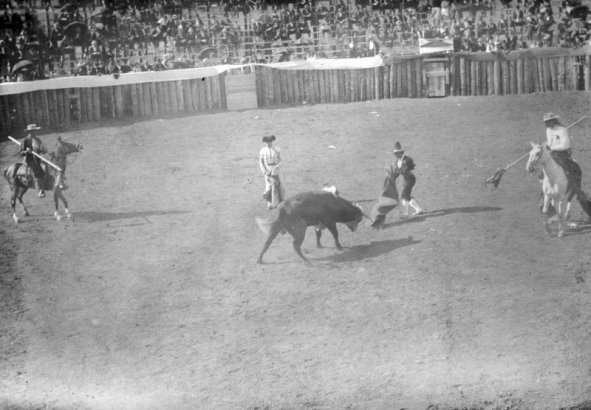In August 1895, the town of Gillett, Colorado, hosted an event that would never be repeated in state history - a genuine, Mexican bullfight.
The bullfights were the brainchild of one Joe Wolfe, a PR-savvy casino owner who hoped to establish Gillett as nothing less than the, "Monte Carlo of the West."
Wolfe's vision wasn't as far-fetched as you might think, but his idea for hosting animal bloodsports in the high plains did not go over well with the people of Colorado. By the time the last bullfighter had hung up his cape, several bulls were dead; Wolfe's pockets were considerably lighter; and Colorado had seen its last bullfight.
Welcome to Gillett, Bullfighting Capitol of Colorado
Located just 10 miles from the gold fields of Cripple Creek, Gillett (spelled without an "e") wasn't out of line in its hopes of becoming a gambling mecca. Just a year after its founding the town hosted a thriving entertainment industry with 17 saloons and dance halls; a horse track; and, of course, Mr. Wolfe's casino.
Wolfe hoped that staging a large event would elevate Gillett's fortunes and secure it a spot as the county seat of Teller County. He was so confident that he sunk a great deal of cash into importing four bullfighters from Mexico and constructing an elaborate bullfighting arena capable of seating thousands of spectators.
While Wolfe's plan looked great on paper, there were a few logistical and political factors he failed to consider. For starters, not everyone in Gillett thought that killing bulls in an arena for sport was such a good idea. These folks took their concerns to the state capitol in Denver where they found a sympathetic ear in Governor Albert W. McIntire. McIntire immediately dispatched the State Humane Officer to confirm that a bullfight was really going to take place.
Blood on the Sand, Law Enforcement in the Stands
When the day of the bullfights arrived, Gillett was inundated with visitors from across the state. According to the Rocky Mountain News, as many as 50,000 people showed up to see the spectacle. Among those attending were representatives of state and local law enforcement agencies who vowed to arrest anyone who actually attempted to fight a bull.
Though deputies arrested the bullfighters several times, they didn't actually get to stop the first bullfight. Wolfe had pre-paid the anticipated fines and hustled the fighters through an abbreviated legal process in a nearby makeshift courthouse. (The bullfighters were charged with cruelty to animals and paid only a token fine.)
Unfortunately for everyone involved, especially the animals, the bulls chosen for the fights were not the sorts of bulls you'd normally find in a bullfighting ring south of the border. These sad animals were common farm animals and were in no way prepared to participate in bloodsports of any kind. The bulls, however, were not the only inexperienced participants in the Gillett bullfights.
Wolfe had also hired several local cowboys to act as picadores, the men who actually lance the bull ahead of the final kill. While these men may have been good at their day jobs, they were not versed in the elaborate rituals used to hasten an animal's death in the ring. Suffice to say, the one bull that was actually killed that day (and the bull killed the next day) suffered tremendously.
By the time the bullfighters were ready for the second fight, Wolfe had lost his enthusiasm for fighting bulls and law enforcement and left the arena. With that, the Gillett bullfights were all but done. Though several thousand spectators showed up the second day, the bulls' lack of enthusiasm endeared them to the crowd, and the fights were stopped after a single death. The third day of bullfights was canceled entirely, causing Wolfe no small amount of financial pain.
Whatever Happened to Gillett?
For better or worse, Gillett's time as a destination was short-lived. By 1901 the mining boom that fueled growth in Teller County had petered out and Gillett was on its way to becoming what it is today, a ghost town. On June 16, 1965, the same storm that wreaked havoc on Denver burst a dam near Gillett and wiped out most of what remained of the once-booming burg.
No More Bull(fighting)
Despite its rich history and pageantry, bullfighting is ultimately a bloodsport that's never really sat well with the people of Colorado. That fact was evidenced by the utter failure of the Gillett bullfights to garner popular opinion, even amongst the people actually attending the event. The fact that the Gillett bullfights were Colorado's first, and last, foray into real bullfighting speaks volumes about the character of the state.
Want to see what Colorado's only 'authentic' bullfight looked like? Take a look at our Colorado Bullfighting Gallery.
(For a more complete accounting of the Gillett bullfights, check out Colorado's First and Last Bullfight - 1895, by Frances Melrose, which appeared in the 1958 Denver Brand Book of the Denver Posse of the Westerners. Mr. Melrose researched his work at DPL's Western History Department and used several photos from our collection in the publication.)


Comments
Very interesting article.
Very interesting article. Thanks!
Bullfighting in not and never
Bullfighting in not and never has been a sport. Only one side wins, always. It is an art form, even if badly done.
Add new comment